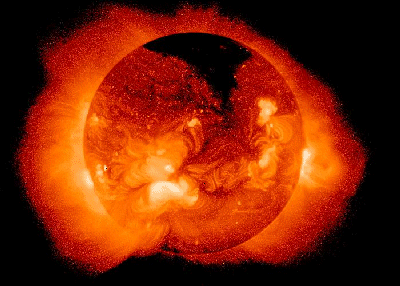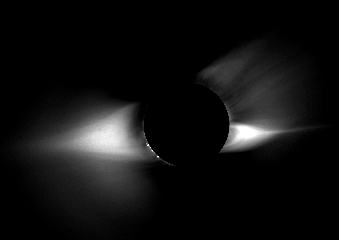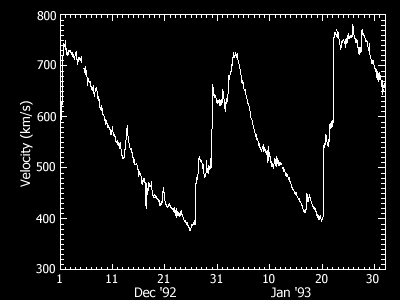

Hi! My name is Jude and I work at NASA's Goddard Space Flight Center, Maryland, USA. This is where the SOHO spacecraft is operated, and I get to play with the latest solar data.
You may have read that the centre of the Sun loses 4 million tonnes of material every second as it uses up fuel to make energy. But did you know it also looses about 4 million tonnes every second from its atmosphere?
So what? The Sun has plenty of atmosphere. It's not going to run out while I'm alive. TRUE, but do you ever lie awake at night wondering if all those tonnes of gas have any effect on you while you're living (or sleeping) on Earth?
I'm going to tell you about the link between coronal holes, the solar wind and Earth. I guess you know what the Earth is and the others names are pretty descriptive - coronal holes are dark, hole-like regions on the Sun we see in X-ray X-ray photographs of the Sun show only the hot gas in the Sun's atmosphere. The solar wind is, well, a wind blowing out from the Sun.
Of course, if that were all there was to say there wouldn't be much point in continuing, so let's dive in and find out a little more.
Why are coronal holes dark? Well, there isn't much gas there - it's all gone! Coronal holes are found at the north and south poles of the Sun, where the magnetic field lines are open. Place your mouse pointer over YES to see the coronal hole outlined.

Now, how does all this relate to the solar wind? Well, coronal holes are the source of most of the solar wind found in space. This is known as the "fast" solar wind. It is a stream of particles flowing from the Sun at speeds around 800km/s. That is nearly 2 million mph!
Fortunately, you would never feel this wind if you were standing in it because it is made up almost entirely of charged hydrogen particles. It also contains small amounts of helium, iron and many other elements.

So, if there is a "fast" solar wind, there must be a "slow" solar wind, right? Correct! The slow solar wind flows at speeds around 400km/s (nearly 1 million mph!! Not so slow, really). Where the "slow" solar wind comes from is one of the hotly debated topics. It might come from the edges of coronal holes, or from the "closed" regions on the Sun, such as streamers . Streamers are bright regions which look like helmets or pointy hats on the Sun. You can see them in this picture, place your mouse pointer over the blue word streamer.
Here is a plot of the solar wind speed measured by the Ulysses spacecraft. Can you tell me when in December 1992 the wind was slowest (below 400 km/s)? To find the answer place your mouse pointer over the green answer.
We can't measure the solar wind directly on Earth. This is because we have a shield protecting us. This shield is the Earth's own magnetic field. It deflects the solar wind away from the Earth. However, sometimes the solar wind can sneak in at the Earth's poles. This is what causes the Northern and Southern Lights, otherwise known as aurora

So, why study coronal holes and the solar wind? Well, for a start, I want to know how coronal holes form, why they are less dense than the rest of the Sun's atmosphere, and how the solar wind gets accelerated to such high speeds!
Why does the Sun have coronal holes?
Are coronal holes always the same shape and size?
Why is the solar wind so fast?
If you want to learn more about me, put me On the Hotspot.


|